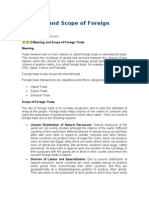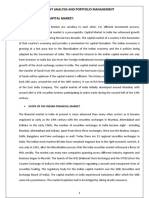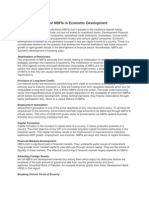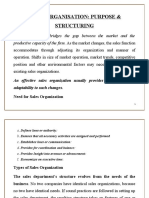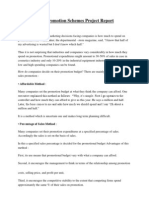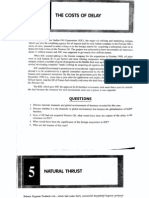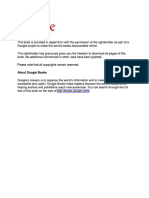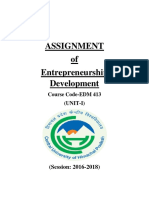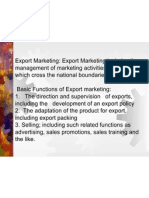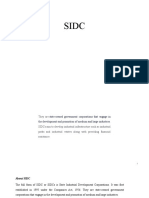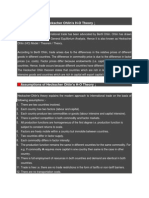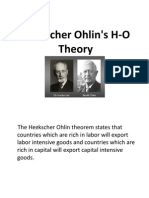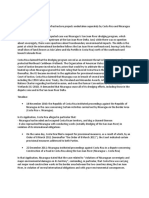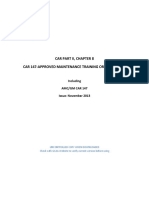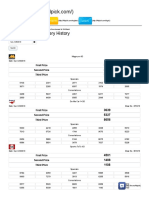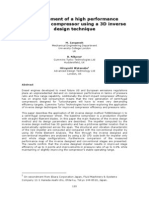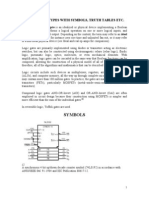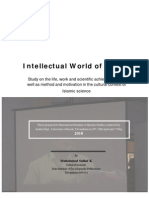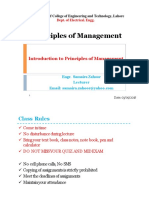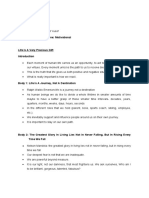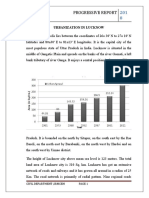Heckscher Ohlin's (HO) Modern Theory of International Trade
Heckscher Ohlin's (HO) Modern Theory of International Trade
Uploaded by
Nitesh AshokCopyright:
Available Formats
Heckscher Ohlin's (HO) Modern Theory of International Trade
Heckscher Ohlin's (HO) Modern Theory of International Trade
Uploaded by
Nitesh AshokOriginal Description:
Original Title
Copyright
Available Formats
Share this document
Did you find this document useful?
Is this content inappropriate?
Copyright:
Available Formats
Heckscher Ohlin's (HO) Modern Theory of International Trade
Heckscher Ohlin's (HO) Modern Theory of International Trade
Uploaded by
Nitesh AshokCopyright:
Available Formats
Heckscher Ohlin's (HO) Modern Theory of International Trade
The Modern Theory of international trade has been advocated by Bertil Ohlin. Ohlin
has drawn his ideas from Heckscher's General Equilibrium Analysis. Hence it is also
known as Heckscher Ohlin (HO) Model / Theorem / Theory.
According to Bertil Ohlin, trade arises due to the differences in the relative
prices of different goods in different countries. The difference in commodity price is
due to the difference in factor prices (i.e. costs). Factor prices differ because
endowments (i.e. capital and labour) differ in countries. Hence, trade occurs because
different countries have different factor endowments.
The Heckscher Ohlin theorem states that countries which are rich in labour will
export labour intensive goods and countries which are rich in capital will export capital
intensive goods
Assumptions of Heckscher Ohlin's H-O Theory
Heckscher-Ohlin's theory explains the modern approach to international trade on the
basis of following assumptions
1. There are two countries involved.
2. Each country has two factors (labour and capital).
3. Each country produce two commodities or goods (labour intensive and capital
intensive).
4. There is perfect competition in both commodity and factor markets.
5. All production functions are homogeneous of the first degree i.e. production
function is subject to constant returns to scale.
6. Factors are freely mobile within a country but immobile between countries.
7. Two countries differ in factor supply.
8. Each commodity differs in factor intensity.
9. The production function remains the same in different countries for the same
commodity. For e.g. If commodity A requires more capital in one country then
same is the case in other country.
10. There is full employment of resources in both countries and demand are
identical in both countries.
11. Trade is free i.e. there are no trade restrictions in the form of tariffs or non-tariff
barriers.
12. There are no transportation costs.
Given these assumption, Ohlin's thesis contends that a country export goods which use
relatively a greater proportion of its abundant and cheap factor. While same country
imports goods whose production requires the intensive use of the nation's relatively
scarce and expensive factor.
Understanding the Concept of Factor Abundance
In the two countries, two commodities & two factor model, implies that the capital rich
country will export capital intensive commodity and the labour rich country will export
labour intensive commodity. But the concept of country being rich in one factor or other
is not very clear. Economists quite often define factor abundance in terms of factor
prices. Ohlin himself has followed this approach. Alternatively factor abundance can be
defined in physical terms. In this case, physical amounts of capital & Labour are to be
compared.
Price Criterion for defining Factor Abundance - A country where capital is
relatively cheaper and labour is relatively costly is said to be capital rich country.
Whereas a country where labour is relatively cheaper and capital is relatively
costly is said to be labour rich country.
Price of the factor can be symbolically measured as follows.
In above relation
1. P refers to price of the factor,
2. K refers to capital,
3. L refers to Labour,
4. E stands for England, and
5. I stands for India
The above analysis highlights a fact that in England capital is cheap, and
hence it is a capital abundant country. Where as in India, Labour is cheaper and thus
it is a labour rich country.
Diagram Explaining Heckscher Ohlin's H-O Theory
Let us take an example of same two countries viz; England and India where England is
a capital rich country while India is a labour abundant nation.
In the above diagram XX is the isoquant (equal product curve) for the
commodity X produced in England. YY is the isoquant representing commodity Y
produced in India. It is very clear that XX is relatively capital intensive while YY is
relatively labour incentive. The factor capital is represented on Y-axis while the factor
labour is represented on the horizontal X-axis.
PA is the price line or budget line of the country England. The price line PA is
tangent to XX at E. The price line PA is also tangent to YY isoquant at K. The point K
will help us to find out how much of capital and labour is required to produce one unit
of Y in England.
P1B is the price line of the country India, The price line P1B is tangent to YY at
I. The price line RS which is drawn parallel to P1B is tangent to XX at M. This will
help us to find out how much of capital and labour is required to produce one unit of
commodity X in India.
Under the given situations, the country England will choose the combination E.
This means more specialisation on capital goods. It will not choose the combination K
because it is more labour intensive and less capital intensive.
Thus according to Ohlin, England will specialise on production of goods X by
using the cheap factor capital extensively while India specialises on commodity Y by
using the cheap factor labour available in the country.
The Ohlin's theory concludes that:
The basis of internal trade is the difference in commodity prices in the two countries.
Differences in the commodity prices are due to cost differences which are the results of
differences in factor endowments in two countries. A capital rich country specialises in
capital intensive goods & exports them. While a Labour abundant country specialises in
labour intensive goods & exports them.
Limitations of Heckscher Ohlin's H-O Theory
Heckscher Ohlin's Theory has been criticised on basis of following grounds :-
1. Unrealistic Assumptions: Besides the usual assumptions of two countries, two
commodities, no transport cost, etc. Ohlin's theory also assumes no qualitative
difference in factors of production, identical production function, constant return
to scale, etc. All these assumptions makes the theory unrealistic one.
2. Restrictive: Ohlin's theory is not free from constrains. His theory includes only
two commodities, two countries and two factors. Thus it is a restrictive one.
3. One-Sided Theory: According to Ohlin's theory, supply plays a significant role
than demand in determining factor prices. But if demand forces are more
significant, a capital abundant country will export labour intensive good as the
price of capital will be high due to high demand for capital.
4. Static in Nature: the H-O Model is also static in nature. The theory is based on a
given state of economy and with a given production function and does not
accept any change.
5. Wijnholds's Criticism: According to Wijnholds, it is not the factor prices that
determine the costs and commodity prices but it is commodity prices that
determine the factor prices.
6. Consumers' Demand ignored: Ohlin forgot an important fact that commodity
prices are also influenced by the consumers' demand.
7. Haberler's Criticism: According to Haberler, Ohlin's theory is based on partial
equilibrium. It fails to give a complete, comprehensive and general equilibrium
analysis.
8. Leontief Paradox: American economist Dr. Wassily Leontief tested H-O theory
under U.S.A conditions. He found out that U.S.A exports labour intensive goods
and imports capital intensive goods, but U.S.A being a capital abundant country
must export capital intensive goods and import labour intensive goods than to
produce them at home. This situation is called Leontief Paradox which negates
H-O Theory.
9. Other Factors Neglected: Factor endowment is not the sole factor influencing
commodity price and international trade. The H-O Theory neglects other factors
like technology, technique of production, natural factors, different qualities of
labour, etc., which can also influence the international trade.
Source: Akrani, Gaurav. "Heckscher Ohlin's (HO) Modern Theory of International
Trade." Heckscher Ohlin's (HO) Modern Theory of International Trade. N.p., 21 Mar. 2011. Web.
11 Aug. 2013. <http://kalyan-city.blogspot.com/2011/03/heckscher-ohlin-ho-modern-theory-
of.html>.
You might also like
- Meaning and Scope of Foreign TradeDocument2 pagesMeaning and Scope of Foreign Tradekrisszen67% (3)
- The Architect SaysDocument3 pagesThe Architect SaysjohnNo ratings yet
- Exim PolicyDocument22 pagesExim PolicyTarun Arora100% (1)
- Unit IV - (Managerial Economics) Market Structures & Pricing StrategiesDocument37 pagesUnit IV - (Managerial Economics) Market Structures & Pricing StrategiesAbhinav SachdevaNo ratings yet
- Entrepreneurs Definitions and FunctionsDocument10 pagesEntrepreneurs Definitions and FunctionsmuntaquirNo ratings yet
- Unit 3: The Role of Public Policies in Governing BusinessDocument41 pagesUnit 3: The Role of Public Policies in Governing BusinessAnonymous 5RO7Xov3A4No ratings yet
- Investment Analysis and Portfolio Management (Mba 3RD Sem) (Akanksha)Document30 pagesInvestment Analysis and Portfolio Management (Mba 3RD Sem) (Akanksha)priyank chourasiyaNo ratings yet
- Role of NBFIs in Economic DevelopmentDocument2 pagesRole of NBFIs in Economic DevelopmentFaizan ChNo ratings yet
- Fundamental Analysis in SAPMDocument6 pagesFundamental Analysis in SAPMRoshan VargheseNo ratings yet
- IFM M.Com NotesDocument36 pagesIFM M.Com NotesViraja Guru0% (1)
- DTP Full NotesDocument114 pagesDTP Full NotesCHAITHRANo ratings yet
- Chapter 1 PDFDocument20 pagesChapter 1 PDFANILNo ratings yet
- Presentation On:-: Export Sales Organization & Export Sales Man (Recruiting & Training)Document26 pagesPresentation On:-: Export Sales Organization & Export Sales Man (Recruiting & Training)Vivek Kumar SharmaNo ratings yet
- Pricing Strategy Report - Group 5 - Maruti BalenoDocument19 pagesPricing Strategy Report - Group 5 - Maruti BalenodwnpiyushNo ratings yet
- National Income 1Document11 pagesNational Income 1Adesh KyalNo ratings yet
- Unit 3 SALES ORGANISATIONDocument24 pagesUnit 3 SALES ORGANISATIONpiyushsithaNo ratings yet
- Sales Promotion Schemes Project ReportDocument12 pagesSales Promotion Schemes Project ReportAshish GaurNo ratings yet
- Interconnected Stock Exchange (ISE)Document9 pagesInterconnected Stock Exchange (ISE)Anoop KoshyNo ratings yet
- Credit CreationDocument7 pagesCredit CreationwubeNo ratings yet
- Capital StructureDocument4 pagesCapital StructureNaveen GurnaniNo ratings yet
- Economic Environment of Business (An Introduction)Document75 pagesEconomic Environment of Business (An Introduction)siddheshkaraneNo ratings yet
- Sickness in Small EnterprisesDocument15 pagesSickness in Small EnterprisesRajesh KumarNo ratings yet
- Objectives of The Price PolicyDocument3 pagesObjectives of The Price PolicyPrasanna Hegde100% (1)
- Unit IV (Part I) : Absorption Versus Variable Costing: Distinctive FeaturesDocument26 pagesUnit IV (Part I) : Absorption Versus Variable Costing: Distinctive FeaturesRaghav JindalNo ratings yet
- International Liquidity and Reserve ProblemsDocument34 pagesInternational Liquidity and Reserve ProblemsUthama Veeran50% (2)
- Unit 3 International BusinessDocument25 pagesUnit 3 International BusinessMrudul MuraliNo ratings yet
- Role of Monetary and Fiscal PDFDocument15 pagesRole of Monetary and Fiscal PDFVinay Kumar KumarNo ratings yet
- EVALYDocument6 pagesEVALYTahsin MuntasirNo ratings yet
- Unorganised Workers in India: Issues and ConcernsDocument35 pagesUnorganised Workers in India: Issues and Concernssuresh0% (1)
- Nature and Function of Profit: Dr. Gopalakrishna B.VDocument21 pagesNature and Function of Profit: Dr. Gopalakrishna B.VsamrulezzzNo ratings yet
- Surrogate MarketingDocument18 pagesSurrogate MarketingOnkar KapoorNo ratings yet
- Comparative Financial Analysis On Sbi Life Insurance & Icici Prudential Life InsuranceDocument62 pagesComparative Financial Analysis On Sbi Life Insurance & Icici Prudential Life InsuranceNeha KumariNo ratings yet
- Salesmanship: Unit - 3Document82 pagesSalesmanship: Unit - 3yatin rajputNo ratings yet
- Forex - Problems in Exchange RateDocument26 pagesForex - Problems in Exchange Rateyawehnew23No ratings yet
- Balance of PaymentsDocument34 pagesBalance of PaymentsRavi Sista100% (1)
- Political EnvironmentDocument18 pagesPolitical EnvironmentJay BhatiaNo ratings yet
- Responsibility Accounting - Types, Features, Prerequisites & ExamplesDocument8 pagesResponsibility Accounting - Types, Features, Prerequisites & Examplesprakashzodpe2013No ratings yet
- Cases in BEDocument3 pagesCases in BEzs28844100% (1)
- Question Bank - International Business ManagementDocument110 pagesQuestion Bank - International Business ManagementSandeep SahadeokarNo ratings yet
- The History of Origin and Growth of Merchant Banking Throughout The WorldDocument18 pagesThe History of Origin and Growth of Merchant Banking Throughout The WorldJeegar Shah0% (1)
- Industrial LicensingDocument26 pagesIndustrial LicensingJuiÇý ßitëNo ratings yet
- The Rise of Socialist ThoughtDocument29 pagesThe Rise of Socialist Thoughtwallace471x35652No ratings yet
- 1845962535marketing Management C B Gupta N Rajan NDocument17 pages1845962535marketing Management C B Gupta N Rajan Nppkkgjf0% (1)
- Tax EvasionDocument5 pagesTax Evasiongfreak0100% (1)
- Q. 10 Benefits of DerivativesDocument2 pagesQ. 10 Benefits of DerivativesMAHENDRA SHIVAJI DHENAK100% (1)
- Anand Engineering College, Agra Bba Program Business EthicsDocument8 pagesAnand Engineering College, Agra Bba Program Business EthicsakshayaecNo ratings yet
- Consumer Perception of Big BazaarDocument132 pagesConsumer Perception of Big Bazaaramardeep chaddaNo ratings yet
- Assignment of Entrepreneurship Development: (Session: 2016-2018)Document65 pagesAssignment of Entrepreneurship Development: (Session: 2016-2018)kusumNo ratings yet
- International Trade EnvironmentDocument17 pagesInternational Trade Environmentankitkmr25No ratings yet
- Chapter 5 Ethical Behaviour & Implications For AccountantsDocument18 pagesChapter 5 Ethical Behaviour & Implications For Accountantsmanoj parmarNo ratings yet
- Export MarketingDocument10 pagesExport MarketingHasib JaforNo ratings yet
- The Japanese ModelDocument3 pagesThe Japanese ModelSiva Prasad PasupuletiNo ratings yet
- NotesDocument13 pagesNotesMabvuto PhiriNo ratings yet
- Tranfer of Knowledge Across National BordersDocument10 pagesTranfer of Knowledge Across National BordersIneha Thind100% (1)
- SIDCDocument37 pagesSIDCRAJESH VNo ratings yet
- Lesson 1 Introduction To Law and The Meaning and EssentialsDocument201 pagesLesson 1 Introduction To Law and The Meaning and EssentialsSandip Dankhara100% (2)
- Recruitment Process Outsourcing A Complete Guide - 2020 EditionFrom EverandRecruitment Process Outsourcing A Complete Guide - 2020 EditionNo ratings yet
- Introduction To Heckscher OhlinDocument5 pagesIntroduction To Heckscher OhlinShrikant ModiNo ratings yet
- Heckscher OhlinDocument4 pagesHeckscher OhlinSidNo ratings yet
- Hec Ohlin TheoryDocument13 pagesHec Ohlin TheoryPavithra PRabhuNo ratings yet
- Heckscher Ohlin's H-O TheoryDocument9 pagesHeckscher Ohlin's H-O TheorybinnysatanNo ratings yet
- Las Science 7 W7 8Document6 pagesLas Science 7 W7 8Darven CinchezNo ratings yet
- San Juan Case DigestDocument4 pagesSan Juan Case DigestKrissy OsabelNo ratings yet
- PD Fault Location On Cable Lengths: Application NoteDocument17 pagesPD Fault Location On Cable Lengths: Application NoteInsan AzizNo ratings yet
- Car Part Ii, Chapter 8 Car 147-Approved Maintenance Training OrganisationsDocument50 pagesCar Part Ii, Chapter 8 Car 147-Approved Maintenance Training OrganisationsBhaskerNegi100% (1)
- 4 D Predict 12818Document4 pages4 D Predict 12818yourhunkie100% (1)
- Experimentation and Practical Skills Template: 4205CIV Hydraulics - Academic Year 2018 - 2019Document3 pagesExperimentation and Practical Skills Template: 4205CIV Hydraulics - Academic Year 2018 - 2019Zainab SattarNo ratings yet
- 10 Development of A High Performance Centrifugal Compressor Using A 3D Inverse Design TechniqueDocument11 pages10 Development of A High Performance Centrifugal Compressor Using A 3D Inverse Design TechniqueSubhash PadmanabhanNo ratings yet
- Your Results For - Multiple-Choice Questions - ADocument4 pagesYour Results For - Multiple-Choice Questions - ARavi SatyapalNo ratings yet
- GEOL 4320/6320 Questions For Exams I and IIDocument4 pagesGEOL 4320/6320 Questions For Exams I and IIHollowAnggara100% (1)
- Logic Gate, Types With Symbols, Truth Tables EtcDocument6 pagesLogic Gate, Types With Symbols, Truth Tables EtcChidinma Glory EjikeNo ratings yet
- ACSLDocument2 pagesACSLAnonymous HyOfbJ6No ratings yet
- Bmcg2513 - Project Guideline - Transformer ToysDocument4 pagesBmcg2513 - Project Guideline - Transformer ToysUnstraightable FingerNo ratings yet
- Intellectual World of Al TusiDocument18 pagesIntellectual World of Al Tusisulhaf100% (1)
- Math Investigatory ProjectDocument15 pagesMath Investigatory ProjectrahulNo ratings yet
- Introduction To Principles of ManagementDocument37 pagesIntroduction To Principles of ManagementAb CNo ratings yet
- (F) Non Verbal Commu - HapticsDocument2 pages(F) Non Verbal Commu - Hapticsstudy dNo ratings yet
- Outline - Motivational Persuasive SpeechDocument2 pagesOutline - Motivational Persuasive SpeechSalsabila AinaaNo ratings yet
- Draft Feedback 1Document5 pagesDraft Feedback 1api-298381854No ratings yet
- Urbanization in LucknowDocument8 pagesUrbanization in Lucknowved prakash raoNo ratings yet
- T.D Hemanth Kumar Aws Devops Engineer:: Professional SummaryDocument3 pagesT.D Hemanth Kumar Aws Devops Engineer:: Professional Summaryaravi173No ratings yet
- Double Entry Journal Source 4Document2 pagesDouble Entry Journal Source 4api-383729698No ratings yet
- Arithmetic and Geometric SequenceDocument3 pagesArithmetic and Geometric SequenceMeena Amina ReyhoundNo ratings yet
- Busby Pebbles Newsletter PDFDocument27 pagesBusby Pebbles Newsletter PDFvkfbhjmcj8100% (1)
- License R2017a.licDocument8 pagesLicense R2017a.licNermin Imamovic50% (2)
- How Can You Best Explain Divergence and CurlDocument8 pagesHow Can You Best Explain Divergence and CurlattiquejavaidNo ratings yet
- Trabalho de Campo de InglêsDocument10 pagesTrabalho de Campo de InglêsSimõesNo ratings yet
- QUARTILEDocument2 pagesQUARTILErhianreign estudilloNo ratings yet
- Peter K. Smith, Craig H. Hart - Blackwell Handbook of Childhood Social DevelopmentDocument682 pagesPeter K. Smith, Craig H. Hart - Blackwell Handbook of Childhood Social DevelopmentAlejandro Israel Garcia Esparza100% (3)
- Completion TechniqueDocument143 pagesCompletion TechniquenaefmubarakNo ratings yet
